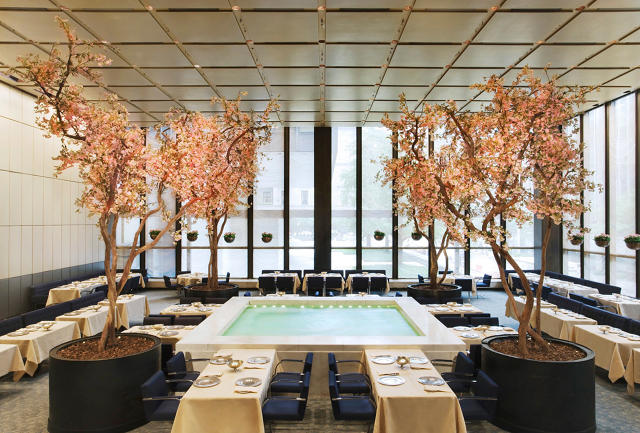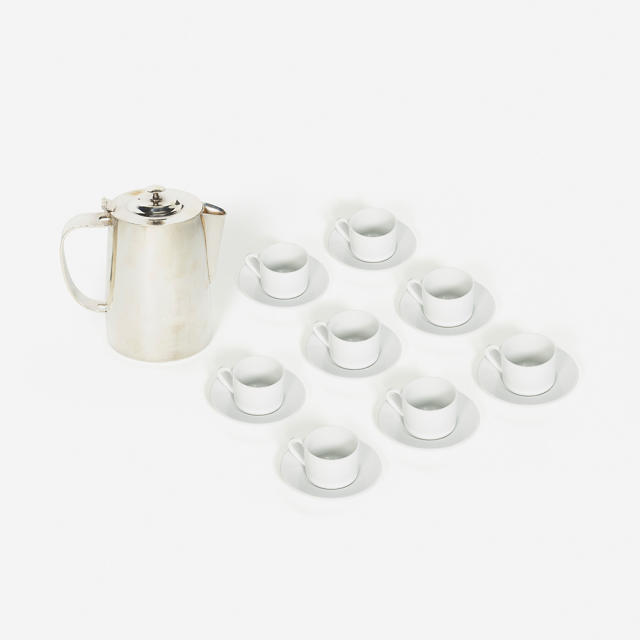It's easy to wax nostalgic about a place like the Four Seasons, one of the most pedigreed spaces in New York City. So when the landmarked Modernist restaurant designed by Philip Johnson and Mies van der Rohe announced it would be closing in July 2016, fans and history buffs were crushed. And to make the situation more devastating, the owners decided to auction off all the restaurant's custom-designed contents.
Located in the Seagram Building—essentially the blueprint for modern skyscrapers—the restaurant, lounge, and bar all became a stage for three-martini power lunches and dinners from a bygone era of midcentury glamour. Before building menus around seasonal produce became par for the course, the Four Seasons paved the way.
When Philip Johnson was hired to design the interiors within Mies van der Rohe's shell, he had a hand in every detail, from picking panels of book-matched burl wood cladding the walls to shrouding the windows in a glittering brass-chain screen and hiring Garth and Ada Louis Huxtable—a husband-and-wife industrial designer and critic, respectively—to create all of the tableware and silverware for the space.

Now, after over 60 years of operation, the Four Seasons is closing, auctioning its contents, and moving to a new location after a messy breakup with the Seagram's owner, Aby Rosen. Rosen, a real estate developer and art collector, wanted to bring in a more financially lucrative restaurant into the landmarked space and decided not to renew the restaurant's lease, which expires this summer, at its current rate of $27 per square foot.
Owners Alex von Bidder and Julian Niccolini were told they'd have to pay market rate, which is around $125 per square foot, instead. In the end, Niccolini and von Bidder were priced out, and a new restaurant will now take the Four Seasons' place.

The architecture and design community is, understandably, angry about this decision. Now, in what seems like a dagger into the side of preservationists—and a glaring gap in what the "landmark" designation covers—von Bidder and Julian Niccolini are auctioning off the restaurant's contents, which aren't protected. Architectural details that are, like the metal curtains, bar, and Richard Lippold sculptures, will remain. (This move is most likely to help fund the restaurant's new location, to be designed by Brazilian architect Isay Weinfeld, a couple blocks away.)
"To see the dispersal of the furnishings at an auction is painful," Aaron Betsky, an architecture critic and current dean of the Frank Lloyd Wright School of Architecture, told Dezeen. "For decades, The Four Seasons restaurant has been a space that provided one of the rarest phenomena in Modernism: a place where the architecture, the furniture, the table settings, the service, the food, and even the clientele was of a piece."

Since its opening in 1959, the restaurant has attracted a who's-who set of corporate titans, captains of industry, and very loyal customers (with deep pockets), many of which have expressed interest in buying some of the restaurant's pieces as memorabilia. Wright, a Chicago-based auction house specializing in design, is handling the July 26 sale, one of many auction houses that vied for the opportunity to host one of the most highly publicized—and hotly controversial—design sales of the last century.
"Our proposal was to be as sensitive as possible to the Landmarks Designation to make sure that we're not overreaching in terms of the works available for sale," says Brent Lewis, director of Wright's New York branch, when I ask about being involved in a controversial sale. "We wanted to do it in a way that's respectful to the space. By the time we got involved, the decision had been made to pursue this route. The owners of the restaurant had made efforts to sell the furniture to [Rosen] and in the end they decided that [the auction] would be a good option as it would give patrons the option to participate in the sale and participate in the history of the restaurant." (Rosen, who is eager to revamp the restaurant, likely wanted nothing to do with the original furnishings.)
The sale will include around 500 different lots with estimates of $300 to $500 for tableware, $2,000 for banquettes, and $5,000 for a pair of bar stools. Wright priced the estimates as if the items were antiques without the restaurant's history and provenance—conservative sums based on what some of these items have fetched in the past. Lewis has received interest from art institutions eager to get their hands on some of the historic furnishings, and is working with the Four Seasons to donate some of the pieces to local museums. But it's mostly been restaurant patrons who've been ringing the auction house—a sign that bidding wars will likely inflate the results. "We're letting the bidders decide what they're worth," Lewis says.

Certain items, like a cracked glass screen in the bar area, that Wright felt were "essential to the design of the space" aren't in the auction, even though they were technically permissible to sell. "This was something Philip Johnson installed with the restaurant in the 1980s for its 20th anniversary," Lewis says. "It's not original. It's important to the space and a key focal point and we would never wish to take that out."
The research behind the auction is unearthing and recording narratives surrounding the space. "One of the things we do is tell stories," Lewis says. "The Four Seasons is a great story. It's an incredible for architectural significance and cultural impact. The furniture, the design, the objects all really speak to this period of 20th-century modem design . . . We've been getting a lot of calls and notes from people who have a personal connection to the space. I talked to an older woman who recounted her first date at the pool room. People for whom the Four Seasons has meant something are excited about the possibility of owning something has an historical significance."
One of the great things about the Four Seasons was that stepping inside felt like traveling back to the golden age of 20th-century design—a rarity in a city obsessed with the new. In museums, you can spy the work of the Huxtables, Johnson, and Mies, but at the restaurant, you could use these objects and sit in the furniture as the designers intended.
A restaurant like the Four Seasons is meant to be experienced in person. No photograph or essay will capture what it's like to see light flicker through Johnson's brass curtains or replicate the feeling of teetering on a precarious cantilevered bar stool while indulging in a $25 Manhattan. Now, these pieces will mostly be in private hands. While divorcing the objects from the interior isn't the ideal scenario, the auction will at least give them new homes that appreciate their historic—and sentimental—value.